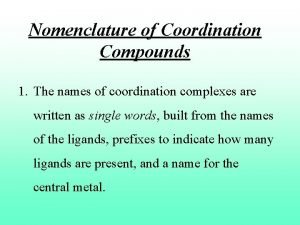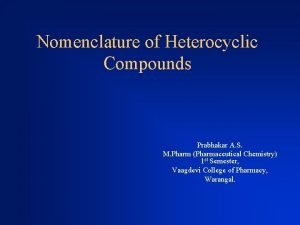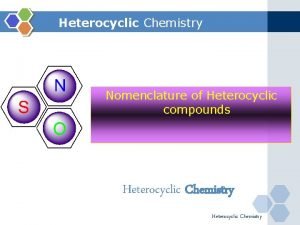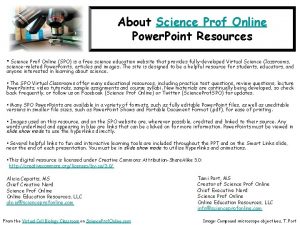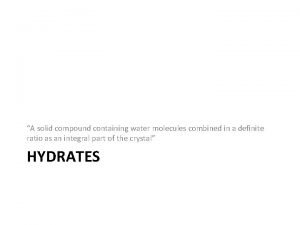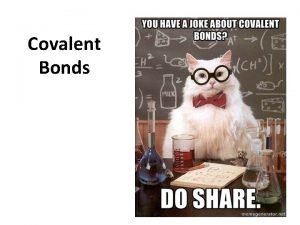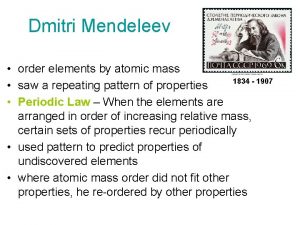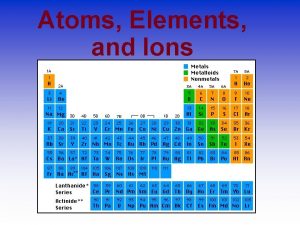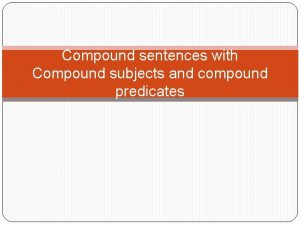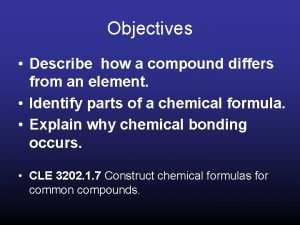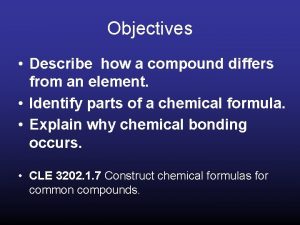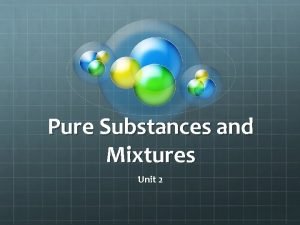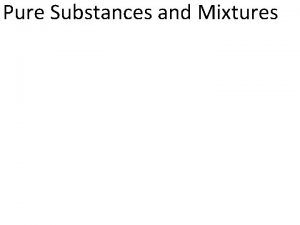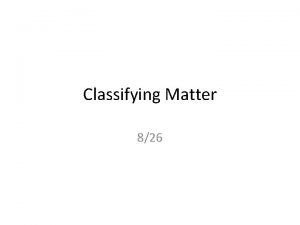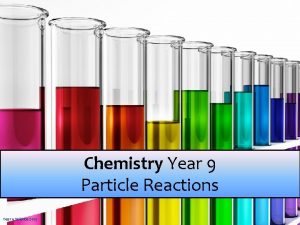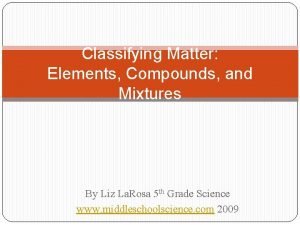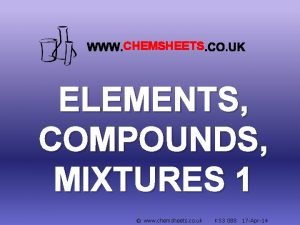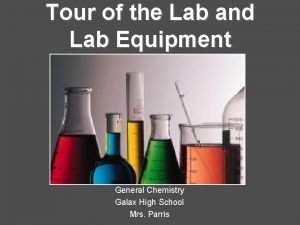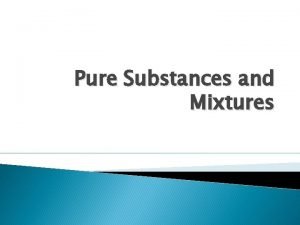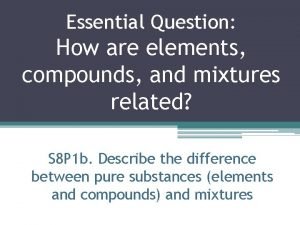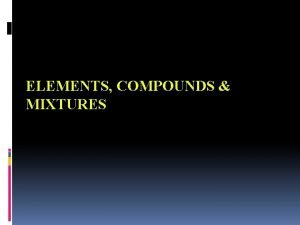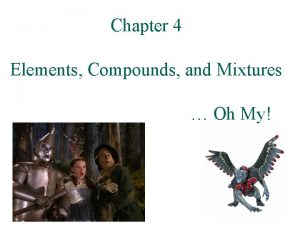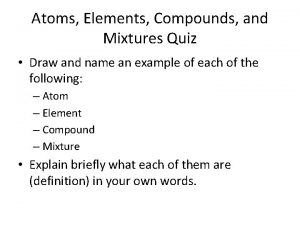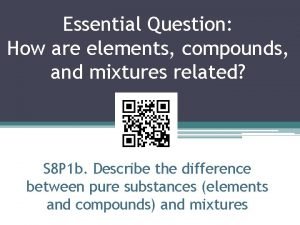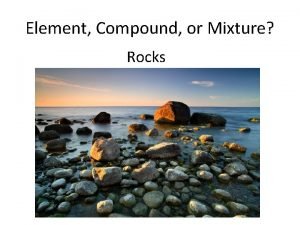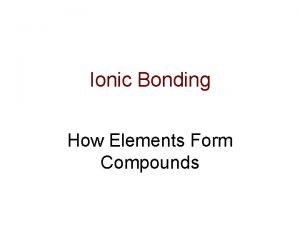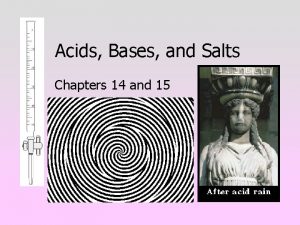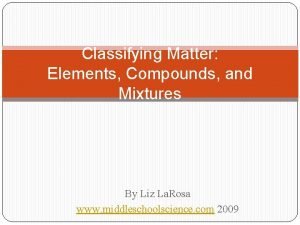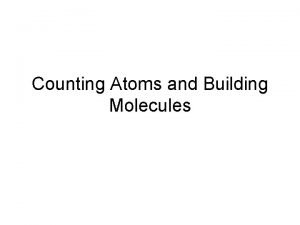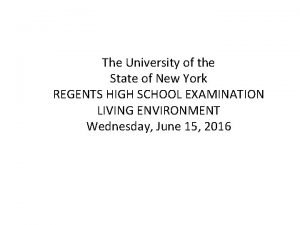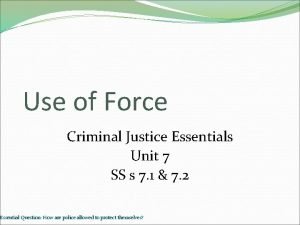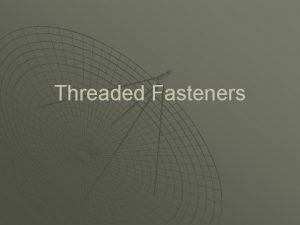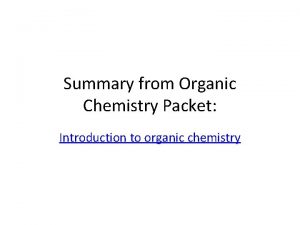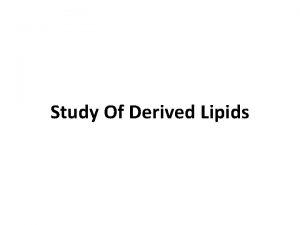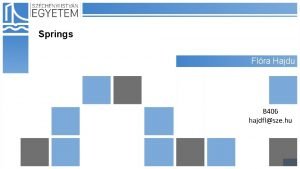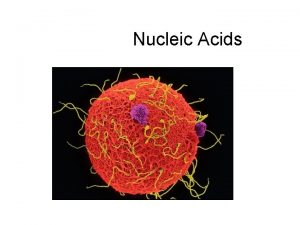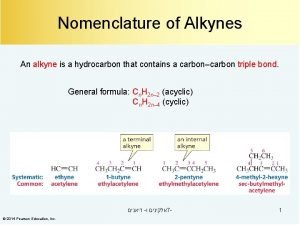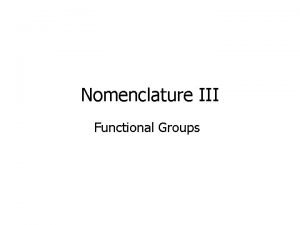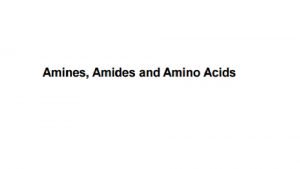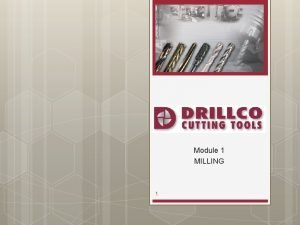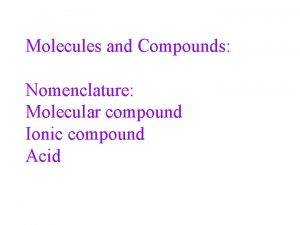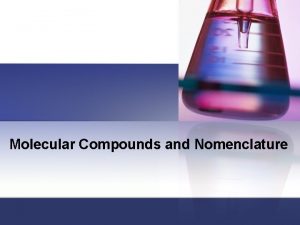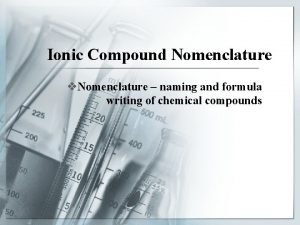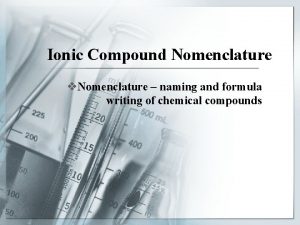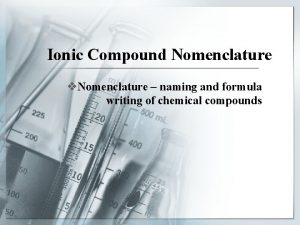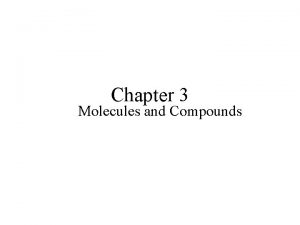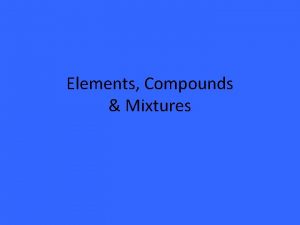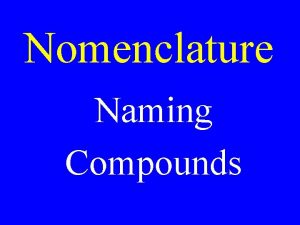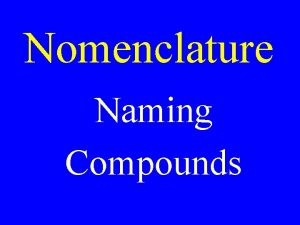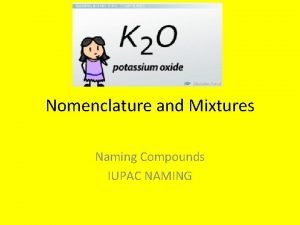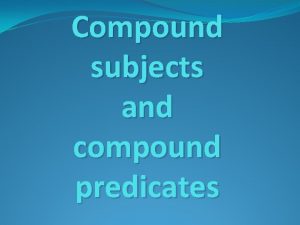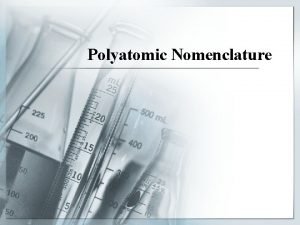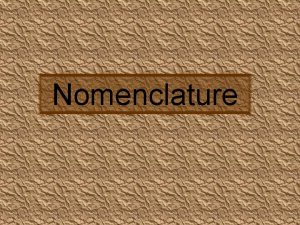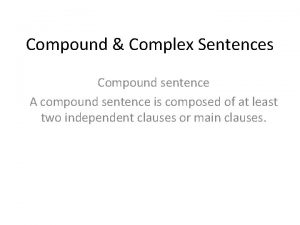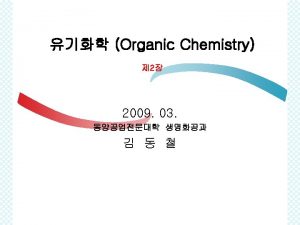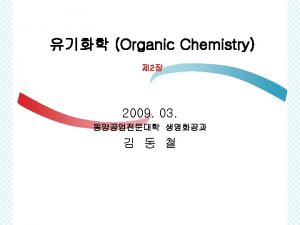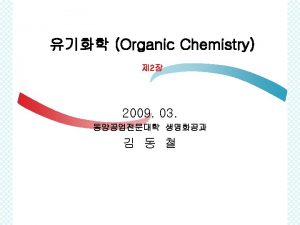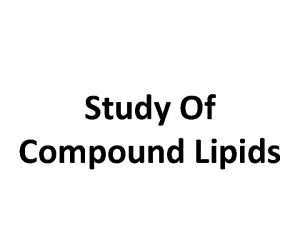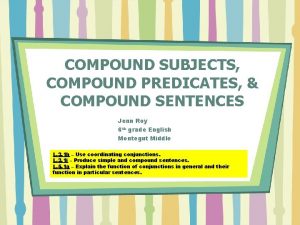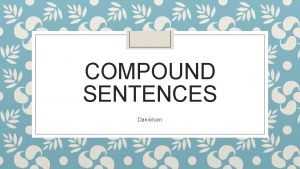Molecules and Compounds Nomenclature Compounds vs Elements Compound













































































- Slides: 77

Molecules and Compounds: Nomenclature

Compounds vs. Elements Compound 1: Table Salt Properties: Soluble crystals, stable, edible Elements (Components) • Sodium – shiny, reactive, poisonous • Chlorine – pale yellow gas, reactive, poisonous Compound 2: Table sugar Properties: sweet, soluble crystal Elements (Components) : • Carbon – pencil or diamonds • Hydrogen – flammable gas • Oxygen – a gas in air 2

Law of Constant Composition Pure substances have constant composition ü all samples of a pure substance contain the same elements in the same percentages (ratios): Water (H: 11%, O: 89%), Table salt (Na: 39%, Cl: 61%), Sugar ü mixtures have variable composition: Air, Seawater, Concrete, Rocky road ice cream, Coke 3

Why do Compounds Show Constant Composition • the smallest piece of a compound is called a molecule: Water molecule, Sugar molecule • every molecule of a compound has the same number and type of atoms. Water molecule: 2 Hydrogen atom + 1 Oxygen atom; Sugar molecule: 12 Carbon atom + 22 Hydrogen atom + 11 Oxygen atom every sample of the compound will have the same ratio of the elements 4

Chemical Formula Chemical formula: describe the compound by describing the number and type of each atom in the simplest unit of the compound ü molecules or ions (Table salt: Cl+, Na-) • Element represented by its letter symbol: H instead of hydrogen; Na instead of Sodium • #Atoms of each element: the right of the element as a subscript, H 2 O (unless if there is only one atom, the 1 subscript is not written) • Polyatomic groups (multiple atoms in group, example: CO 3) are placed in parentheses if more than one 5

From Composition to Chemical Formula water = H 2 O two atoms of hydrogen and 1 atom of oxygen table sugar = C 12 H 22 O 11 12 atoms of C, 22 atoms of H and 11 atoms O 6

Classifying Pure Substances Element • Atomic: consists of single atoms (Metals, Noble gases) • Molecular: consists of multi-atom molecules (O 2, N 2, Cl 2, etc) Compound • Molecular: consists of molecules made of only nonmetals (CO 2, H 2 O) • Ionic: consists of cations (Na+) and anions (Cl-) 7

Elements and Compounds 8

Classify each of the following: Element atomic/molecular Compound molecular/ionic • • • aluminum, Al = atomic element aluminum chloride, Al. Cl 3 = ionic compound chlorine, Cl 2 = molecular element acetone, C 3 H 6 O = molecular compound carbon monoxide, CO = molecular compound cobalt, Co = atomic element 9

Molecular Elements Certain elements occur as 2 atom molecules • Rule of 7’s ü there are 7 common diatomic elements ü find the element with atomic number 7, N ü make a figure 7 by going over to Group 7 A, then down ü don’t forget to include H 2 VIIA H 2 N 2 7 O 2 F 2 Cl 2 Br 2 I 2 10

Molecular Elements = Metalloid H = Nonmetal N O F Cl Br I

Molecular Compounds • two or more nonmetals • smallest unit is a molecule • Common examples: H 2 O • CO 2 (as in soda and dry ice) • NH 3 (as in Windex), • Table sugar C 11 H 22 O 11 12

Ionic Compounds Ions: Metals (Cation Mx+) and Nonmetals (Anion Ny -) • No individual molecules!! • have a 3 -dimensional array of cations and anions made of formula units: Na. Cl, Mg. O • Na+ Cl- Na+ Cl • Cl- Na+ • Na+ Cl- 13

Binary Molecular Compounds: Two Nonmetals (such as CO 2) 1. Name first element in formula first ü use the full name of the element 2. Name the second element in the formula with an -ide ü as if it were an anion, however, remember these compounds do not contain ions! 3. Use a prefix in front of each name to indicate the number of atoms a) Never use the prefix mono- on the first element 14

Subscript - Prefixes • 1 = mono-; ünot used on first nonmetal • 2 = di • 3 = tri • 4 = tetra- • • • 5 = penta 6 = hexa 7 = hepta 8 = octadrop last “a” if name begins with vowel 15

Exceptions when Naming Molecular Compounds of course, water Other common exceptions: • NH 3: ammonia (as in Windex) • H 2 S: hydrogen sulfide • HCl: hydrogen chloride (same for HX, where X = halogen) • CH 4: methane (as in natural gas) • H 2 O 2: hydrogen peroxide 16

Example – Naming Binary Molecular BF 3 1. Is it one of the common exceptions? H 2 O, NH 3, CH 4, C 12 H 22 O 11 = No! 2. Identify Major Class B = is a nonmetal because it is on the right side of the PT F = is a nonmetal because it is on the right side of the PT Molecular 3. Identify the Subclass 2 elements Binary Molecular 17

Example – Naming Binary Molecular BF 3 4. Name the first element boron 5. Name the second element with an –ide fluorine fluoride 6. Add a prefix to each name to indicate the subscript monoboron, trifluoride 7. Write the first element with prefix, then the second element with prefix ü Drop prefix mono from first element boron trifluoride 18

Practice: Naming Molecular Compounds • • CO Cl. O 3 SO 2 P 2 O 5 N 2 O 4 IF 7 SF 6 19

Key to Naming Molecular Compounds • • CO Cl. O 3 SO 2 P 2 O 5 N 2 O 4 IF 7 SF 6 carbon monoxide chlorine trioxide sulfur dioxide diphosphorus pentoxide dinitrogen tetroxide iodine heptoxide sulfur hexafluoride 20

Ionic Compounds • Made of Cation (+) and Anion (-) • Name: Cation Anion example: Na. Cl Sodium Chloride üCation: ØType I metal ØType II metal ØPolyatomic ion: ammonium NH 4+ üAnion: ØNonmetal: Chloride Cl-, Oxide O 2ØPolyatomic ion: SO 42 - , OH- , NO 321

Metal Cations: Type I (Groups IA, IIA, AZA) üonly have one possible charge ØGroups IA, IIA, Ag+, Zn 2+, Al 3+ üCharge by position on the Periodic Table ØIA = +1, IIA = +2, ØAg+ (IB), Zn 2+(IIB) Al 3+(IIIA) How do you know a metal cation is Type II? its not Type I !!! 22

Metal Cations: Type II: Metal ions that are other than Type I Common Examples: Fe 2+/3+, Cu+/2+, Cr 3+/6+, Mn 2+/4+, Pb 2+/4+, Sn 2+/4+, etc ) ühave more than one possible charge üdetermine charge by charge on anion How do you know a metal cation is Type II? its not Type I !!! 23

Metal Cations: Type I vs. Type II = Type I Metal = Type II Metal Al Zn Ag

Monatomic Nonmetal Anion (An-) • How much is the charge? the position on the Periodic Table • Name of the anion: change ending on the element name to –ide 4 A = -4 5 A = -3 6 A = -2 7 A = -1 C 4 - = carbide N 3 - = nitride O 2 - = oxide F- = fluoride Si 4 - = silicide P 3 - = phosphide S 2 - = sulfide Cl- = chloride 25

Net charge of Ionic Compound =0 • Net charge = Positive charge from cation(s) + Negative charge from Anion(s) = 0 • Example: Compound Al 2(SO 4)3, the Net charge = 2 x (+3) + 3 x (-2) = +6 - 6 = 0 26

Name of Ionic Compounds • Name: Cation Anion: Sodium Chloride ü Cation: ØType I metal = metal name : Na+ => Sodium, Mg 2+ => Magnesium ØType II metal = metal name(charge): Fe 3+ Iron(III), Cu 2+ Copper(II) ØPolyatomic ion = name of polyatomic ion, NH 4+ => Ammonium ü Anion: ØNonmetal = stem of nonmetal name + ide, Chloride, Oxide ØPolyatomic ion = name of polyatomic ion, SO 42 - => Sulfate, OH- => Hydroxide, NO 3 - => Nitrate 27

Type I Binary Ionic Compounds Binary: only two kinds of ions in one UNIT Example: Mg. O, Ca. Cl 2 • Metal listed first in formula & name 1. Metal Cation Nonmetal Anion 2. Cation name <= Metal name: Magnesium, Calcium 3. Nonmetal anion <= Nonmetal name ends with –ide: Oxide, Chloride 28

Example – Naming Binary Ionic, Type I Metal Cs. F 1. Is it one of the common exceptions? H 2 O, NH 3, CH 4, C 12 H 22 O 11 No! 2. Identify Major Class Cs = is a metal because it is on the left side of the PT F = is a nonmetal because it is on the right side of the PT Ionic 3. Identify the Subclass 2 elements, Binary Ionic 4. Is the metal Type I or Type II Cs is in Group IA, Type I 29

Example – Naming Binary Ionic, Type I Metal Cs. F 5. Identify cation and anion Cs = Cs+ because it is Group 1 F = F- because it is Group 7 6. Name the cation Cs+ = cesium 7. Name the anion F- = fluoride 8. Full name: Cation name first, Anion name last cesium fluoride 30

Type II Binary Ionic Compounds Metal listed first in formula & name 1. Metal cation Nonmetal anion 2. metal cation Metal(Roman Numeral): to indicate its charge. Iron(II), Copper(I) ü determine charge from anion charge ü Common Type II cations in Table 5. 5 3. Nonmetal anion Nonmetal name ended with –ide: Chloride, Oxide Example: Iron(II) chloride, Copper(I) oxide 31

How to find the charge on Type II metal ions? • Example: Name Compound Fe 2(SO 4)3 Since the sum of all charges equals zero, the charge on iron ions are unknown and sulfate each has – 2 charge, then we have 2 x Fe + 3 x (-2) = 0 Fe = +3, each iron ion has a charge of +3 Name: iron(III) sulfate Key: knowing the charge on ANIONs! 32

Example – Naming Binary Ionic, Type II Metal Cu. Cl 1. Is it one of the common exceptions? H 2 O, NH 3, CH 4, C 12 H 22 O 11 = No! 2. Identify Major Class Cu = is a metal because it is on the left side of the PT Cl = is a nonmetal because it is on the right side of the PT Ionic 3. Identify the Subclass 2 elements, Binary Ionic 4. Is the metal Type I or Type II Cu is not in Group IA, IIA, or (Al, Ga, In) Type II 33

Example – Naming Binary Ionic, Type II Metal Cu. Cl 5. Identify cation and anion Cl = Cl- because it is Group 7 Cu = Cu+ to balance the charge 6. Name the cation Cu+ = copper(I) 7. Name the anion Cl- = chloride 8. Write the cation name first, then the anion name copper(I) chloride 34

Practice: Naming Ionic compounds • • Hg. F 2 Cu. I 2 Ca. Cl 2 Fe 2 O 3 Sn. Cl 4 Mg 3 N 2 Ag 2 S 35

Naming Ionic compounds Hints: find type II ion charge from anion • • Hg. F 2 : Two F- = -2 Hg = +2 Cu. I 2 : Two I- = -2 Cu = +2 Ca. Cl 2 : both fixed charges Fe 2 O 3 : Three O 2 - = -6 Fe = +3 Sn. Br 4 : Four Br- = -4 Sn = +4 Mg 3 N 2 : both fixed charges Ag 2 S : both fixed charges 36

Answer key: names of ionic compounds • • Hg. F 2 = Mercury(II) fluoride Cu. I 2 = copper(II) iodide Ca. Cl 2 = calcium chloride Fe 2 O 3 = Iron(III) oxide Sn. Br 4 = tin(IV) bromide Mg 3 N 2 = magnesium nitride Ag 2 S = silver sulfide 37

Polyatomic Ions symbol of the polyatomic ion called nitrate symbol of the polyatomic ion called sulfate Mg(NO 3)2 Ca. SO 4 compound called magnesium nitrate compound called calcium sulfate implied “ 1” subscript on magnesium parentheses to group two NO 3’s implied “ 1” subscript on calcium no parentheses for one SO 4 38

Polyatomic Ions: Nitrate NO 3 -, Sulfate SO 42 subscript indicating two NO 3 groups no subscript indicating one SO 4 group Mg(NO 3)2 Ca. SO 4 compound called magnesium nitrate compound called calcium sulfate implied “ 1” subscript on nitrogen, total 2 N stated “ 3” subscript on oxygen, total 6 O implied “ 1” subscript on sulfur, total 1 S stated “ 4” subscript on oxygen, total 4 O 39

Polyatomic Anions: -ATE ions CO 32 - NO 3 - carbonate nitrate Si. O 32 - PO 43 - SO 42 - Cl. O 3 - silicate phosphate sulfate chlorate As. O 43 - Se. O 42 - Br. O 3 - arsenate selenate bromate IO 3 iodate 40

Periodic Pattern of Polyatomic Ions -ate groups IIIA 3 BO 3 IVA VA VIIA 2 CO 3 NO 3 2 Si. O 3 3 PO 4 2 SO 4 Cl. O 3 3 As. O 4 2 Se. O 4 Br. O 3 2 Te. O 4 IO 3 41

Patterns for Polyatomic Ions 1. elements in the same Group form similar polyatomic ions ü same number of O’s and same charge Cl. O 3 - = chlorate (-1 charge) Br. O 3 - = bromate (-1 charge) 2. if the polyatomic ion starts with H, the name adds hydrogen- prefix before name and add 1 to the charge CO 32 - = carbonate HCO 3 -1 = hydrogen carbonate 42

Patterns for Polyatomic Ions -ate ion üchlorate = Cl. O 3 - • -ate ion + 1 O same charge, per- prefix üperchlorate = Cl. O 4 - • -ate ion – 1 O same charge, -ite suffix üchlorite = Cl. O 2 - • -ate ion – 2 O same charge, hypo- prefix, -ite suffix ühypochlorite = Cl. O 43

Polyatomic Anions: -ite, hypo- -ite, (-ate), per- -ate Cl. Ohypochlorite NO 2 - PO 33 - SO 32 - Cl. O 2 - nitrite phosphite sulfite chlorite NO 3 - PO 43 - SO 42 - Cl. O 3 - nitrate phosphate sulfate chlorate Cl. O 4 perchlorate 44

-ATE/-ITE ions in Our Lives Cl. O(bleach) NO 2 - PO 33 - SO 32 - Cl. O 2 - (preserve meat) (plant medicine) (wine, oxygen buster) (bleach, disinfect) NO 3 - PO 43 - SO 42 - Cl. O 3 - (fertilizer, explosives) (bone/teeth, fertilizer, soda) (plaster, car battery, sea salt) (older pyrotechnics) Cl. O 4 - (pyrotechnics, solid fuel rocket) 45

Polyatomic Ions to Remember Name Formula acetate C 2 H 3 O 2 – hypochlorite Cl. O– carbonate CO 32– chlorite Cl. O 2– hydrogen carbonate (aka Bicarbonate) HCO 3 chlorate Cl. O 3– hydroxide OH– perchlorate Cl. O 4– nitrate NO 3– sulfate SO 42– nitrite NO 2– Hydrogen sulfate (aka Bisulfate) HSO 4– permanganate Mn. O 4– sulfite SO 32– chromate Cr. O 42– dichromate Cr 2 O 7 Hydrogen sulfite (aka Bisulfite) HSO 3– ammonium NH 4+ cyanide CN– – 2– 46

Other Polyatomic Ions in Our Lives C 2 H 3 O 2 – In vinegar as acetic acid CO 32– Soda drink HCO 3– Baking soda, baking power, acid spill neutralizer OH– In liquid plumber/Drano as Na. OH Mn. O 4– Disinfectant, “aging” for movie making Cr. O 42– Chrome plating (faucet, etc. ) CN– Highly Poisonous; Plant seeds; blue pigment NH 4+ Fertilizer; metabolic waste from animals 47

Other Polyatomic Ions in Our Lives Cl. O(bleach) NO 2 - PO 33 - SO 32 - Cl. O 2 - (preserve meat) (plant medicine) (wine, oxygen buster) (bleach, disinfect) NO 3 - PO 43 - SO 42 - Cl. O 3 - (fertilizer, explosives) (bone/teeth, fertilizer, soda) (plaster, car battery, sea salt) (older pyrotechnics) Cl. O 4 - (pyrotechnics, solid fuel rocket) 48

Compounds Containing Polyatomic Ions • • Type I metal + Polyatomic ion: Na. NO 3 Type II metal(charge) + Polyatomic ion : Cu. SO 4 Polyatomic cation + Nonmetal ion (-ide): NH 4 Cl Polyatomic cation + Polyatomic ion: (NH 4)2 SO 4 Important!: If, and only if, more than ONE polyatomic ions are present in a formula, use parenthesis and subscript to indicate the number of polyatomic ions 49

Example – Naming Ionic with Polyatomic Ion Na 2 SO 4 1. Is it one of the common exceptions? H 2 O, NH 3, CH 4, C 12 H 22 O 11 = No! 2. Identify Major Class Na = is a metal because it is on the left side of the PT SO 4 = is a polyatomic ion Ionic 3. Identify the Subclass compound has 3 elements Ionic with Polyatomic Ion 4. Is the metal Type I or Type II Na is in Group IA, Type I 50

Example – Naming Ionic with Polyatomic Ion Na 2 SO 4 5. Identify the ions Na = Na+ because in Group 1 SO 4 = SO 42 - a polyatomic ion 6. Name the cation Na+ = sodium (Type I) 7. Name the anion SO 42 - = sulfate 8. Write the name of the cation followed by the name of the anion sodium sulfate 51

Example – Naming Ionic with Polyatomic Ion Fe(NO 3)3 1. Is it one of the common exceptions? H 2 O, NH 3, CH 4, C 12 H 22 O 11 = No! 2. Identify Major Class Fe = is a metal because it is on the left side of the PT NO 3 = is a polyatomic ion because it is in ( ) Ionic 3. Identify the Subclass there are 3 elements Ionic with Polyatomic Ion 4. Is the metal Type I or Type II Fe is not in Group IA, IIA, or (Al, Ga, In) Type II 52

Example – Naming Ionic with Polyatomic Ion Fe(NO 3)3 5. Identify the ions NO 3 = NO 3 - a polyatomic ion Fe = Fe+3 to balance the charge of the 3 NO 3 -1 6. Name the cation Fe+3 = iron(III) (Type II) 7. Name the anion NO 3 - = nitrate 8. Write the name of the cation followed by the name of the anion iron(III) nitrate 53

Practice: Naming Ionic compounds • • Hg 2 SO 4 Cu. Cl. O 3 Zn(NO 3)2 Fe. CO 3 Sn(SO 3)2 Co. PO 4 Al(Cl. O 4)3 54

Hints: Naming Ionic compounds • • Hg 2 SO 4 : charge of sulfate = -1 Cu. Cl. O 3 : charge of chlorate = -1 Zn(NO 3)2 charge of nitrate = -1 Fe. CO 3 : charge of carbonate = -2 Sn(SO 3)2: charge of sulfite = -1 Co. PO 4 : charge of phosphate = -3 Al(Cl. O 4)3 : charge of perchlorate = -1 55

Keys: Naming Ionic compounds • • Hg 2 SO 4 : mercury(I) sulfate Cu. Cl. O 3 : copper(I) chlorate Zn(NO 3)2 zinc nitrate Fe. CO 3 : iron(II) carbonate Sn(SO 3)2: tin(IV) sulfite Co. PO 4 : cobalt(III) phophate Al(Cl. O 4)3 : aluminum perchlorate 56

Acids • Contain H+ cation and anion • Hydrogen (H) as first element in formula • Binary acids (Hn. X) have H+ cation and nonmetal anion • Oxyacids (Hn. XOm) have H+ cation and polyatomic anion 57

Naming Acids All names have acid at end • Binary Acids (Hn. X) = hydro prefix + stem of the name of the nonmetal + ic suffix Example: HCl (Hydrochloric acid) • Oxyacids (Hn. XOm : H 2 CO 3 , H 2 SO 4) ü if polyatomic ion ends in –ate = name of polyatomic ion with –ic suffix : H 2 SO 4 (Sulfuric acid); H 2 CO 3 (Carbonic acid); HNO 3 (Nitric acid); H 3 PO 4 (Phosphoric acid) ü if polyatomic ion ends in –ite = name of polyatomic ion with –ous suffix 58

Naming Binary Acids – HF 1. First of all, it is binary acid HX 2. Identify the anion F F-, fluoride because Group 7 A 2. Name the anion with an –ic suffix F- = fluoride fluoric 3. Add a hydro- prefix to the anion name hydrofluoric 4. Add the word acid to the end hydrofluoric acid 59

Naming Oxyacids: H 2 SO 4 1. Identify the anion SO 4 = SO 42 - = sulfate 2. If the anion has –ate suffix, change it to –ic. If the anion has –ite suffix, change it to -ous SO 42 - = sulfate sulfuric 3. Write the name of the anion followed by the word acid sulfuric acid (kind of an exception, to make it sound nicer!) 60

Practice: Naming Acids first: what is the anion? • • HNO 3 HCl. O 3 HBr H 2 CO 3 H 2 SO 3 H 3 PO 4 HCl. O 4 nitrate chlorate bromide carbonate sulfite phosphate perchlorate 61

Practice: Naming Acids • • HNO 3 nitrate nitric acid HCl. O 3 chlorate chloric acid HBr bromide hydrobromic acid H 2 CO 3 carbonate carbonic acid H 2 SO 3 sulfite sulfurous acid H 3 PO 4 phosphate phosphoric acid HCl. O 4 perchlorate perchloric acid 62

Formula-to-Name Flow Chart 63

Review: Naming Compounds • • Cu. SO 3 Ag. Cl. O N 2 O 5 H 2 S Fe. I 2 Sn(NO 3)4 Ba 3(PO 4)2 (NH 4)2 S 1. Common exceptions? H 2 O, NH 3, CH 4, C 12 H 22 O 11 2. Identify as Molecular or Ionic? 3. Identify • • Binary molecular Type I or II metal ion 64

Review: Naming Compounds • • Cu. SO 3 Ag. Cl. O N 2 O 5 H 2 S Fe. I 2 Sn(NO 3)4 Ba 3(PO 4)2 (NH 4)2 S copper(II) sulfite silver hypochlorite dinitrogen pentoxide hydrosulfuric acid iron(II) iodide tin(IV) nitrate barium phosphate ammonium sulfide 65

Write Chemical Formula using the charge of known ions • Example: Compound between Ca 2+ and PO 43 - , the number of ions of each needs to be 3 and 2, so that the combined charge = 3 x (+2) + 2 x (-3) = 0 Therefore the formula for the compound is Ca 3(PO 4)2 66

Write Chemical Formula using the charge of known ions “Criss-Cross-Simplify”: • The charge of an ion turns into the subscript (the number) of the counterpart ion Pb 4+ O 2 - Pb 2 O 4 • Since the subscripts in an ionic compound represents the RATIO among the ions, the subscripts need to be simplified when there is common denominator Pb 2 O 4 Pb. O 2 67

Practice: Writing formulas (I) • • copper(II) chloride aluminum oxide magnesium phosphide iron(II) bromide lead(II) sulfide zinc iodide sodium nitride 68

Hints for Writing formulas (I): Charges on Cations and Anions • • copper(II) chloride: Cu 2+ and Claluminum oxide: Al 3+ and O 2 magnesium phosphide : Mg 2+ and P 3 iron(II) bromide : Fe 2+ and Brlead(II) sulfide : Pb 2+ and S 2 zinc iodide : Zn 2+ and Isodium nitride : Na+ and N 369

Key for Writing formulas (I): use criss-cross-reduce • • copper(II) chloride aluminum oxide magnesium phosphide iron(II) bromide lead(II) sulfide zinc iodide sodium nitride Cu. Cl 2 Al 2 O 3 Mg 3 P 2 Fe. Br 2 Fe. S Zn. I 2 Na 3 N 70

Practice: Write Chemical Formulae • • Chromium(II) Chloride Cesium phosphate Lead(II) oxide Zinc nitrate Iron(III) sulfite Strontium nitride Ammonium carbonate 71

Key: Write Chemical Formulae • • Chromium(II) Chloride Cesium phosphate Lead(II) oxide Zinc nitrate Iron(III) sulfite Strontium nitride Ammonium carbonate Cr. Cl 2 Cs 3 PO 4 Pb. O Zn(NO 3)2 Fe 3(SO 3)2 Sr 3 N 2 (NH 4)2 CO 3 72

Practice: Writing formulas (I) • • copper(I) sulfate aluminum chlorate magnesium phosphate iron(II) carbonate lead(II) acetate zinc sulfite sodium nitrite Nitrogen gas 73

Hints for Writing formulas (I): Charges on Anions • • copper(I) sulfate: -2 for sulfate aluminum chlorate: -1 for chlorate magnesium phosphate: -3 for phosphate iron(II) carbonate : -2 for carbonate lead(II) acetate: -1 for acetate zinc sulfite : -2 for sulfite sodium nitrite: -1 for nitrite Nitrogen gas: atomic or molecular element? 74

Key: Writing formulas (I) • • copper(I) sulfate: Cu 2 SO 4 aluminum chlorate: Al(Cl. O 3)3 magnesium phosphate: Mg 3(PO 4)2 iron(II) carbonate : Fe. CO 3 lead(II) acetate: Pb(C 2 H 3 O 2)2 zinc sulfite : Zn. SO 3 sodium nitrite: Na. NO 2 Nitrogen gas: N 2 75

More on Writing formulae • • copper(II) sulfate aluminum perchlorate hydroiodic acid iron(III) bromide Diphosphorus pentoxide lead(IV) nitride zinc carbonate helium gas 76

Key: Writing formulae • • • copper(II) sulfate Cu. SO 4 aluminum perchlorate Al(Cl. O 4)3 hydroiodic acid HI iron(III) bromide Fe. Br 3 Diphosphorus pentoxide P 2 O 5 lead(IV) nitride Pb 3 N 4 zinc carbonate Zn. CO 3 ammonium nitrite NH 4 NO 2 helium gas He 77
 Mixture of compounds diagram
Mixture of compounds diagram Organic molecules vs inorganic molecules
Organic molecules vs inorganic molecules Functional groups priority
Functional groups priority Coordination compound nomenclature
Coordination compound nomenclature Heterocyclic compounds nomenclature
Heterocyclic compounds nomenclature Heterocyclic compounds nomenclature
Heterocyclic compounds nomenclature Nomenclature of binary ionic compounds
Nomenclature of binary ionic compounds All compounds are molecules
All compounds are molecules Oil rig biology
Oil rig biology A solid compound that contains water molecules
A solid compound that contains water molecules Molecules of compound
Molecules of compound Venn diagram ionic and covalent compounds
Venn diagram ionic and covalent compounds Which elements exist as diatomic molecules
Which elements exist as diatomic molecules Diatomic elements
Diatomic elements Pauline and bruno have a big argument
Pauline and bruno have a big argument Simple predicate examples
Simple predicate examples Simple compound complex sentences quiz
Simple compound complex sentences quiz Compound predicates examples
Compound predicates examples A compound differs from an element in that a compound
A compound differs from an element in that a compound A compound differs from an element in that a compound
A compound differs from an element in that a compound Elements and compounds worksheet
Elements and compounds worksheet Honey is homogeneous or heterogeneous
Honey is homogeneous or heterogeneous Elements compounds and mixtures worksheet
Elements compounds and mixtures worksheet Is a bag of m&ms a mixture or pure substance
Is a bag of m&ms a mixture or pure substance Elements and compounds examples
Elements and compounds examples Periodic table mixtures
Periodic table mixtures Types of matter elements compounds and mixtures
Types of matter elements compounds and mixtures Elements compounds and mixtures ks3
Elements compounds and mixtures ks3 Section 1 atoms elements and compounds
Section 1 atoms elements and compounds Chemistry in biology section 2 chemical reactions
Chemistry in biology section 2 chemical reactions Striker lab equipment
Striker lab equipment A substance
A substance Study jams elements and compounds
Study jams elements and compounds Is sterling silver a pure substance
Is sterling silver a pure substance Elements compounds and mixtures oh my worksheet
Elements compounds and mixtures oh my worksheet Elements compounds and mixtures quiz
Elements compounds and mixtures quiz Elements and compounds
Elements and compounds Chapter 6 section 1 atoms elements and compounds
Chapter 6 section 1 atoms elements and compounds Is rock a element compound or mixture
Is rock a element compound or mixture What elements combine to make propane
What elements combine to make propane Aluminum ionic bond
Aluminum ionic bond Acid and base nomenclature
Acid and base nomenclature Pure water compound
Pure water compound Elements and sub elements
Elements and sub elements Relationship between atoms and molecules
Relationship between atoms and molecules Dissolved oxygen and chlorine molecules act as
Dissolved oxygen and chlorine molecules act as Gas to solid
Gas to solid Chiral achiral
Chiral achiral 3bacl2 counting atoms
3bacl2 counting atoms Polar and nonpolar similarities
Polar and nonpolar similarities Atoms molecules and ions
Atoms molecules and ions Atoms molecules and ions
Atoms molecules and ions Atoms molecules and ions
Atoms molecules and ions Atoms molecules and ions
Atoms molecules and ions Atoms ions and molecules
Atoms ions and molecules Atoms ions and molecules
Atoms ions and molecules Farmers may someday clone
Farmers may someday clone Shape and polarity
Shape and polarity Non polar molecules that include fats oils and cholesterol
Non polar molecules that include fats oils and cholesterol States that atoms ions and molecules must collide to react
States that atoms ions and molecules must collide to react Chapter 2 atoms molecules and ions
Chapter 2 atoms molecules and ions Bead like structures formed by dna and histone molecules
Bead like structures formed by dna and histone molecules Example of criminal law
Example of criminal law Nomenclature of bolts
Nomenclature of bolts Oblique cutting example
Oblique cutting example Basic organic nomenclature packet
Basic organic nomenclature packet Unsaturated fat chain
Unsaturated fat chain Spring nomenclature
Spring nomenclature Single key loader
Single key loader E rigging supply
E rigging supply Remington 870 p
Remington 870 p Nucleotide nomenclature
Nucleotide nomenclature Nucleoside and nucleotide
Nucleoside and nucleotide Triple bond nomenclature
Triple bond nomenclature How to name ester
How to name ester Nomenclature amines
Nomenclature amines End mill nomenclature
End mill nomenclature Difference between up milling and down milling
Difference between up milling and down milling



